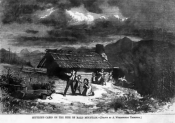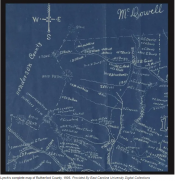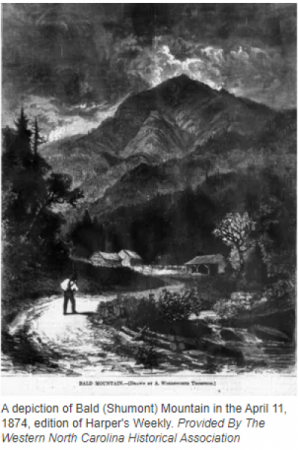WNC History: Rumbling Bald was Rumbling in 1874
The mountains of Western North Carolina occasionally experience earthquakes and seismic activity. These instances often pass without much notice or damage.
In 1874, however, the mountains at the eastern edge of the Hickory Nut Gorge — along the northern arm of modern Lake Lure — began to thunder and shudder the day after a self-styled preacher reportedly exhorted the Lord to cause the earth to tremble and compel the sinners around him to take heed.
Posey (or Posay) Owensby was a farmer living on the McDowell County side of Stone Mountain, a peak on the northern border of Rutherford County, 7 miles north of Chimney Rock. Newspapers of the day, rife with speculation and exaggeration, reported that Owensby held a three-day revival, culminating on Feb. 9, before local residents felt the first tremors under the mountain the following day.
In a state of religious fervor, many locals supposedly panicked, thinking the world was ending or a volcano was set to erupt. Loud booms and rumblings continued episodically for the next month, and news began spreading throughout the country. Geologist Warren DuPre of Wofford College in Spartanburg, South Carolina, embarked on a journey in mid-March “to allay, if possible, the fears of the inhabitants.”
Journeying with a small crew of students, a newspaper editor and a civil engineer, DuPre arrived in Rutherfordton on the 18th and departed the next morning. His party, traveling in six buggies and with five pack horses, journeyed along the Hickory Nut Gap Road, arriving in the Chimney Rock area later that day.

Traveling up and around Shumont (which he called Bald) and Stone mountains, over roads and rough routes which scaled the mountains, he stopped to gather reports from various locals. They included the Elliott family with which he stayed and later wrote about, somewhat condescendingly, in a letter to his father. After determining that blasting on the WNC Railroad near Old Fort, where incarcerated, predominantly Black laborers were forced to create the winding route, was not to blame, DuPre decided the epicenter of the rumblings and shocks lay underneath Stone Mountain. Though he first reported to the Raleigh News & Observer he believed the cause to be volcanism, a month later he concluded it was caused by mundane geologic activity from the natural subsidence of the mountain range. His findings were published later that year in the report of the Smithsonian Institution.
In addition to his geologic investigation, DuPre also addressed some of the reported paranoia and backwardness among locals, finding it had been exaggerated by news accounts. He noted explicitly that the residents of varying intelligence “unanimously contradicted the many rumors of gaping rocks, smoking peaks, sinking caverns, melting snows, &c.” with which newspapers teemed.
Nevertheless, several northern publications — particularly Harper’s Weekly, the New York Herald, and the New York Tribune — ran with the story as the activity continued over the next month. In April, Harper’s described the frenzied mania of locals flocking to preachers in repentance, including a moonshiner who confessed his transgressions to authorities. They also portrayed the inhabitants as “simple hearted … poor whites … ignorant and superstitious to the last degree,” living in crude houses and subsisting on illegal distilling. Interestingly, neither DuPre nor these northern publications acknowledged the numerous Black families who lived in this area, and who they likely would have encountered based on their routes.

While DuPre’s words mostly reached a more limited audience through the Raleigh newspaper and the Smithsonian, the Harper’s Weekly depiction of the region reached a wide readership, coloring many perceptions of Western North Carolina and Appalachia. These events occurred in the same year Frances Fisher Tiernan and her illustrator toured Western North Carolina, inspiring her famed travel novel "The Land of the Sky," which also appeared in another popular New York publication — Appleton’s Journal — and depicted the region in more-positive light to a readership of eager travelers seeking adventure. Here, her traveling characters journey through the Hickory Nut Gorge heading back to the Piedmont, passing by “shaking Bald” Mountain and describing what they recall hearing or experiencing about the rumblings. These events also inspired Jules Verne, who wrote in his 1905 "Master of the World" novel of a rumbling mountain in North Carolina where a mad scientist was testing a device known as “the Terror.”
Today, this episode is remembered occasionally as a humorous footnote, but for a few months in 1874, it turned the scrutiny and curiosity of many East Coast and northern readers onto a series of mountain peaks where stories of modernity versus tradition, and science versus superstition created potentially lasting perceptions of a region.
Later this May, the Western North Carolina Historical Association will lead a hike below Rumbling Bald Mountain exploring this interesting episode. Join us as we parse fact from fiction and examine the people and places the professor met in his short expedition. Stay tuned to our events calendar at www.wnchistory.org for more details to come.

Published in the Citizen-Times
Writen By: Trevor Freeman
Published: April 3, 2022
Note: Trevor Freeman is public programs director for the Western North Carolina Historical Association.



